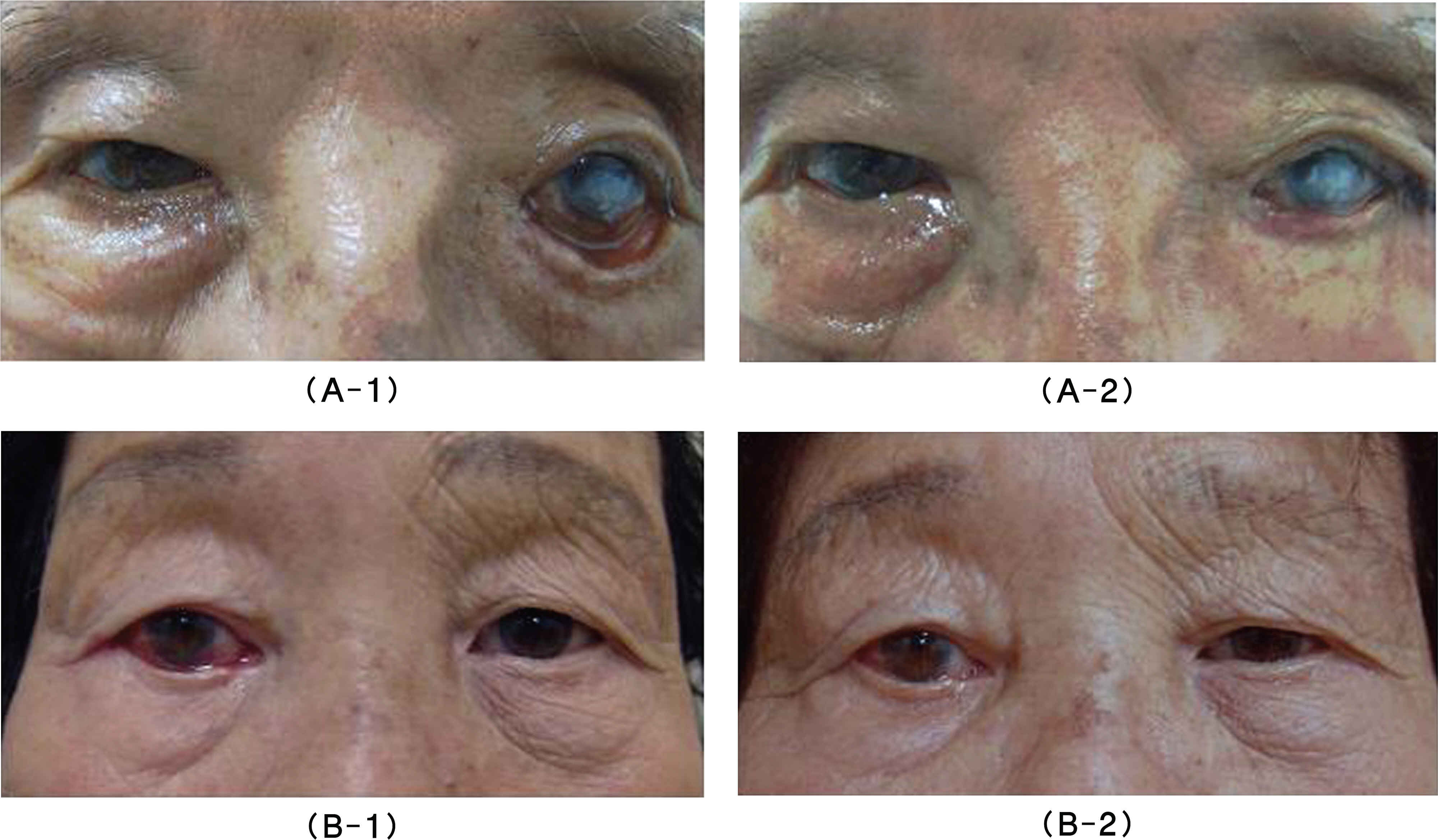J Korean Ophthalmol Soc.
2009 Apr;50(4):497-504. 10.3341/jkos.2009.50.4.497.
The Effect of Augmented Lateral Tarsal Strip for Paralytic Ectropion in Leprosy Patients
- Affiliations
-
- 1Department of Ophthalmology, Gyeongsang National University, College of Medicine, Chinju, Korea. stramast@gaechuk.gnu.ac.kr
- 2Gyeongsang Institute of Health Science, Gyeongsang National University, Chinju, Korea.
- KMID: 2212248
- DOI: http://doi.org/10.3341/jkos.2009.50.4.497
Abstract
-
PURPOSE: To analyze the effect of the augmented lateral tarsal strip for the correction of the paralytic ectropion in leprosy patients.
METHODS
Ten leprosy patients (16 eyelids) with exposed keratitis and lagophthalmos from paralytic ectropion underwent surgery of the augmented lateral tarsal strip. Preoperative and postoperative vertical palpebral aperture, marginal reflex distance, lagophthalmos, and anterior segment findings were recorded at 3 and 6 months after surgery. Postoperative symptomatic and functional improvements were assessed at 6 months after surgery.
RESULTS
There was a significant reduction between preoperative and postoperative measurements for vertical palpebral aperture (3.1+/-0.4 mm), lower marginal reflex distance (2.1+/-1.0 mm), and lagophthalmos (2.0+/-1.2 mm). Eye irritation symptoms and lid functions were improved in all patients. In a survey, the symptomatic, functional satisfaction was achieved in 90% of patients.
CONCLUSIONS
The augmented lateral tarsal strip is a sufficiently effective surgical procedure to be considered in the treatment of paralytic ectropion in leprosy patients.
Figure
Cited by 2 articles
-
The Lateral Tarsal Strip for Paralytic Ectropion in Patients with Leprosy
Mihn-Sook Jue, Jisook Yoo, Min-Soo Kim, Hyang-Joon Park
Ann Dermatol. 2017;29(6):742-746. doi: 10.5021/ad.2017.29.6.742.Clinical Effectiveness of the Lateral Tarsal Strip Procedure
Kun Hoo Na, Joon Sik Lee, Hwa Lee, Se Hyun Baek
J Korean Ophthalmol Soc. 2015;56(6):803-810. doi: 10.3341/jkos.2015.56.6.803.
Reference
-
References
1. Rosenberg S, Goldfarb M. Management of paralytic ectropion. Ann Ophthalmol. 1981; 13:1063–5.2. Ahn TG, Chung WS. Clinical experience of tarsal strip procedure. J Korean Ophthalmol Soc. 1990; 31:1489–94.3. Foda HM. Surgical management of lagophthalmos in patients with facial palsy. Am J Otolaryngol. 1999; 20:391–5.
Article4. Chang L, Oliver J. A useful augmented lateral tarsal strip tarsorrhaphy for paralytic ectropion. Ophthalmology. 2006; 113:84–91.
Article5. Daniel E, Koshy S, Rao GS, Rao PS. Ocular complications in newly diagnosed borderline lepromatous and lepromatous leprosy patients: baseline profile of the Indian cohort. Br J Ophthalmol. 2002; 86:1336–40.
Article6. Toledano Fernández N, García Sáez S, Arteaga Sánchez A, Díaz Valle D. Bilateral lagophthalmos in lepromatous leprosy. Case report. Arch Soc Esp Oftalmol. 2002; 77:511–4.7. Qian JG, Yan LB, Zhang GC. Long-term results after the correction of paralytic ectropion caused with leprosy in 115 eyes. Zhonghua Zheng Xing Wai Ke Za Zhi. 2004; 20:410–1.8. Grauwin MY, Saboye J, Cartel JL. External canthopexy using the Edgerton-Montandon procedure in lagophthalmos of leprosy patients. Technique and indications. Apropos of 30 cases. Ann Chir Plast Esthet. 1996; 41:332–7.9. Kumar P, Saxena RC, Srivastava SN. Leprotic paralytic lagophthalmos with ectropion and its surgical correction. Indian J Ophthalmol. 1986; 34:15–8.10. Yoleri L, Songur E. Modified temporalis muscle transfer for paralytic eyelids. Ann Plast Surg. 1999; 43:598–605.
Article11. Snyder MC, Johnson PJ, Moore JF, Ogren FP. Early versus late gold weight implantation for rehabilitation of the paralytic eyelid. Laryngoscope. 2001; 111:2109–13.12. Woo JM, Jeong SK, Park YG. Gold weight lid implantation for the management of facial nerve palsy. J Korean Ophthalmol Soc. 1995; 36:2067–73.13. Anderson RL. Tarsal strip procedure for correction of eyelid laxity and canthal malposition in anophthalmic socket. Ophthalmology. 1981; 88:192–208.14. Becker FF. Lateral tarsal strip procedure for the correction of paralytic ectropion. Laryngoscope. 1982; 92:382–4.
Article15. Lisman RD, Smith B, Baker D, Arthurs B. Efficacy of surgical treatment for paralytic ectropion. Ophthalmology. 1987; 94:671–81.
Article
- Full Text Links
- Actions
-
Cited
- CITED
-
- Close
- Share
- Similar articles
-
- Lateral tarsal strip operation for the correction of paralytic and involutional Ectropion in Sorokdo Leprosy Patients
- Reappraisal of the lateral tarsal strip in the treatment of paralytic ectropion
- The Lateral Tarsal Strip for Paralytic Ectropion in Patients with Leprosy
- Spacer graft using deep temporal fascia in the treatment of paralytic ectropion
- Involutional Ectropion Repair with the Modified Medial Spindle and the Lateral Tarsal Strip Procedure




